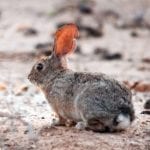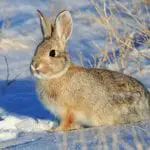Scientific Facts
| Common Name: | Plush Lop |
| Scientific Name: | – |
| Life Span: | Up to 12 years |
| Size: | 2 to 5 pounds |
| Habitat: | Domesticated |
| Country of Origin: | United States, Australia |
Plush Lop Information
While America is widely known for the massive rabbits it loves to breed; the Plush Lop tends to be an exception. This rabbit breed is actually on the compact size even though it actually has two varieties: the regular-sized one and the miniature version. Generally, the Plush Lop is believed to be one of the newer breeds of domesticated rabbits and has been around only since the 90s.
The Plush Lop actually started back in 1995 when Devie D’anniballe created the miniature version. It was bred by crossing the Miniature Lop, a popular miniature rabbit, and the Miniature Rex, another one of the top choices for rabbit owners who love miniature breeds. The reason for crossing booth those breeds was to develop an entirely new and unique kind of rabbit that had the great qualities of both the Miniature Lop and the Miniature Rex. The result was a rabbit that sported a body that is compact and ears that are actually lopped (hence the name).
It was only in 2002 when the regular version of the Plush Lop was bred. Instead of breeding it in the United States, a certain Christine Toyer developed this version of the Plush Lop in Australia when the Standard Rex was crossed with the Dwarf Lop. What turned out was a breed that looked and acted the same way as the miniature Plush Lop but is a bit bigger than the original version.
Even though the regular-sized Plush Lop is becoming popular every year, it is still considered to be in the middle of its development process. Meanwhile, the smaller version of this rabbit is regarded as the more popular variant in the US and in many other places around the world. Australia and the UK are at the forefront of the regular-sized Plush Lop’s continuing development.
Physical Description
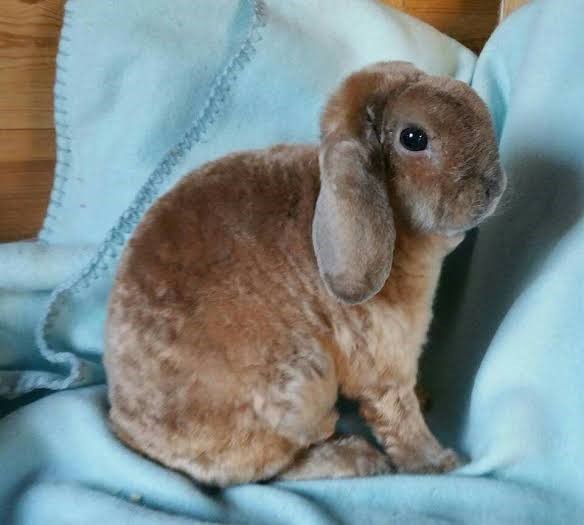
Regardless of whether you have a miniature or a regular version of the Plush Lop, this rabbit will have a body that is compact and small. The best part is that its body also features a rather firm muscle mass as it tends to be quite lean instead of the usual plump and fat kind of rabbit that you often see in most kinds of American breeds of rabbits. This is despite the fact that its loins are well-rounded in a way that it actually is made out of lean muscle instead of fats. In that regard, no matter how small this rabbit may be, it looks strong and athletic instead of how some rabbits look fat and kind of lazy.
Looking at the Plush Lop in a more detailed way, it has a head that seems well-rounded, well-developed, and sits firmly on its shoulders. You will hardly see this animal’s neck as it seems like its head is attached directly on the shoulders. Meanwhile, there is some sort of separation between is eyes. However, the Plush Lop has eyes that are round and large for this rabbit’s size. Its cheeks tend to be the only thing fat about this rabbit as it features round and full cheeks that give it a cuddly look.
The well-developed and well-muscled hind legs should look strong yet short at the same time. Meanwhile, you will notice that the front legs also look just as strong, short, and well-developed as the front legs but are quite straight. Its tail should also be rounded and furry. Female versions of these rabbits might have some sort of dewlap or extra flap of skin on their necks.
What gives this rabbit its iconic name are its ears. The Plush Lop features ears that are furred and very thick. They also sit very close to the rabbit’s cheeks and should be lopped. What that means is that it should have ears that hang down just behind its eyes. You will also notice that you will hardly ever see the inside of the rabbit’s ears.
You could barely see any differences between the miniature and the standard versions. They both have bodies that are compact and well-muscled. However, the major difference tends to be in size as the overall appearance of the miniature Plush Lop makes it look smaller than the standard version. The standard version, due to how lean it is, rarely grows heavier than 5 pounds. Meanwhile, the smaller miniature Plush Lop is somewhere close to 2 or 3 pounds in terms of its overall weight. That means that both the standard and the miniature versions are still quite small and compact compared to the other gigantic breeds of rabbits found in America.
Plush Lops have coats that are soft, smooth, and silky. You will find that it is quite enjoying to stroke its hair from its head all the way down to where its tail starts. Its lopped ears also make stroking its hair a lot easier. Meanwhile, the British Rabbit Council and the American Rabbit Breeders Association accept any sort of pattern or color when it comes to the Plush Lop. That means that there is no distinctiveness as to the color of this rabbit’s coat.
Personality
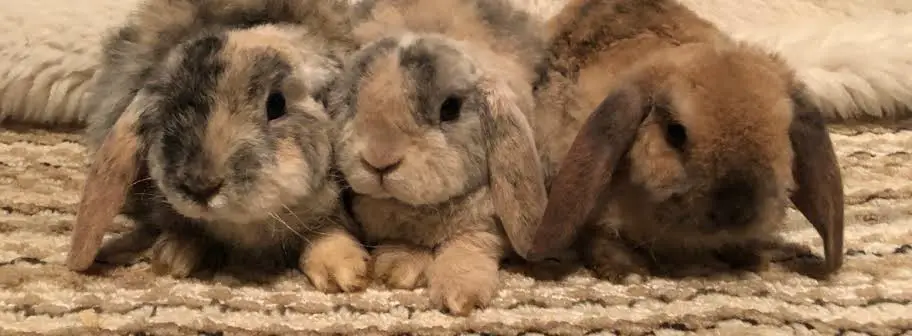
The Plush Lop is as great a pet for a family as any other pet can be due to how it acts like your usual sweet, loving, and affectionate domesticated rabbit. As small as this bunny may be, it has quite a big heart whenever it interacts with its family. It is generally very friendly towards you and will more than likely love to spend its time socializing with the family and other household pets that are safe for rabbits to be with. Moreover, the Plush Lop will not mind if you have it sit on your lap. It might even prefer to actually stay on your lap or to sit close to you while you stroke its head.
Plush Lops are also considered quite docile. This kind of a rabbit will not mind getting petted or even getting handled by its owner or by people who it does not even know. It will most likely not try to struggle whenever you are handling it as it is naturally very receptive to getting carried or petted by humans. This makes it a very easy pet to have as it almost will not show any signs of agitation when you are handling it.
When you let it out of its cage and leave it to have fun on its own, the Plush Lop will show a rather playful and curious side. It will not be too shy about trying to play with rabbit-friendly toys; you give it some. The rabbit will also more than likely get along well with children that would want to play with it. Of course, the Plush Lop is rather curious and will try to learn more about its surroundings to acclimate itself to the type of environment that is outside of its usual habitat inside its cage.
Life Span
The Plush Lops, likely due to its smaller size, is quite hardy and resilient. It is more resistant to different kinds of diseases and illnesses that commonly plague rabbits. In that case, the Plush Lop will be able to live for about 12 years as long as you give it the best kind of care it deserves. Generally, you can expect them to live for at least 5 years.
A Plush Lop will not have any major health problems that can affect its lifespan so long as you are attentive to its basic needs. You have to watch out for ticks, fleas, and worms that can plague it if you are not too careful of what it eats and where it lives. Having it spend a lot of time in your garden will make it vulnerable to such parasites. Also, be sure to give it vegetables that are fibrous and to allow it to play with chew toys to avoid any serious dental problems that commonly affect rabbits. Finally, a Plush Lop is not prone to obesity due to how it naturally is leaner than most of its other domesticated rabbit cousins. But that does not mean that you should allow it to have an unhealthy diet. Always watch portion sizes and make sure that you give it a healthy diet to make sure that it does not go overweight.
Reproduction
Plush Lops have the same kind of breeding pattern and behavior as most other domesticated rabbits because of how they share a common ancestry. These rabbits will be able to breed all year long so long as they are in heat. Plush Lops will be sexually mature by the time they reach 5 months old. There are times when some of these rabbits will be ready for reproduction at 4 months of age. Nevertheless, 5 months seems to be the standard age for most domesticated rabbits. Also, Plush Lops will give birth to a litter size of about 1 to 5 rabbits, given how small they are. They will be able to reproduce multiple times in a single year due to how short their gestation period is and how quick they are to recover from one birth to another.
Behavior
The Plush Lop behaves in the same manner as most other domesticated breeds of rabbits. That means that they are generally well-behaved pets that act as a sort of domesticated animal. Like dogs or cats. They are not prone to any kind of mischief and are good-natured in terms of how they behave with or without their owner around. In other words, you do not have to worry too much about how your Plush Lop behaves.
Due to how friendly and affectionate this rabbit is, the Plush Lop will more than likely want to be around you when you let it out of its cage. It will show a lot of affection towards you by trying to get close to you as much as possible. It even loves hanging around on your lap and relaxing there while you stroke its hair. Allow it to behave in such a way so that it will become more affectionate and friendlier towards you, your family, and your house guests. Imagine having a puppy around as this rabbit loves receiving love and attention from you.
The Plush Lop is also rather curious. When it is not cuddling with you, it can most probably be found exploring its surroundings while learning more about its environment due to its nature as a curious animal. It won’t cause a lot of trouble, but it will try to explore as much as it can. Allow it to exhibit such behavior because of how it promotes the rabbit’s curious personality, and due to how it allows it to have a bit of exercise as it hops around the room, trying to learn about the different things around it.
Plush Lops are also quite playful rabbits that will not mind playing with different kinds of toys that are safe for it to use. They are not the most active breeds of rabbits, but they also are not the laziest as well. Instead, they are actually very controlled and calm when they are doing some sort of physical activity. Other than playing with its toys, it will hop around the room to try to enjoy the freedom you allowed it to have.
Overall, the Plush Lop is a rather behaved yet still calm in terms of how playful and active it is. It will not try to do anything that is out of the normal and will not cause you a lot of trouble due to how it does not have the tendency to do naughty things. This makes it a perfect pet to have for the entire family as small kids and older adults can enjoy having the Plush Lop around.
Eating Habits
The Plush Lop does well on a diet that is similar to the one that most other domesticated rabbits have. That means that they should thrive well on a diet that is grass-based. You can feed it grass that is edible for rabbits, or you can go for hay because it is a lot more affordable and still contains all of the essential nutrients that a Plush Lop needs to stay healthy. Hay should comprise about 70% of the rabbit’s diet. You can also substitute some of the hay with rabbit pellets that are commercially produced to have nutritional benefits that are similar to what your Plush Lop can get from grass or hay.
When it comes to the remaining 30% of its diet, the Plush Lop should be able to get more vitamins and nutrients from different kinds of edible vegetables and leafy greens. Fibrous vegetables are ideal for it to have so that its dental health does not deteriorate in any sort of way. These types of vegetables are good for keeping their teeth in check and for preventing their teeth from overgrowing.
The Plush Lop differs from most other American breeds of domesticated rabbits in the sense that it is not rather fat and also is not prone to obesity. Nevertheless, that is not an excuse for allowing it to binge eat. The Plush Lop might be more muscular and lean than other types of rabbits, but it still has to maintain a diet that is healthy and just right for this rabbit. Watch its portion sizes and make sure to keep track of its feeding schedule to avoid overfeeding it. Allowing it to enjoy some freedom outside of its cage on a regular basis is crucial for your rabbit to stay at a manageable weight as it can have the exercise that it needs to burn some of those calories. Finally, watch out for fruits and vegetables that are high in calories and try to minimize feeding the Plush Lop with those kinds of food.
Water
While the Plush Lop is not the most active breed and is not the most demanding in terms of water, you still cannot overlook the fact that it requires to hydrate itself on a regular basis. Never forget to provide clean and fresh water to your rabbit since hydration is much more important than food. Always make sure that you replace your Plush Lop’s water on a regular basis to avoid any sort of contamination. Also, don’t use a water dish that is too large since there is a danger that it might tip over and cause your bunny to get wet. Plush Lops are not too fond of getting wet and can easily get stressed when they get.
Cage
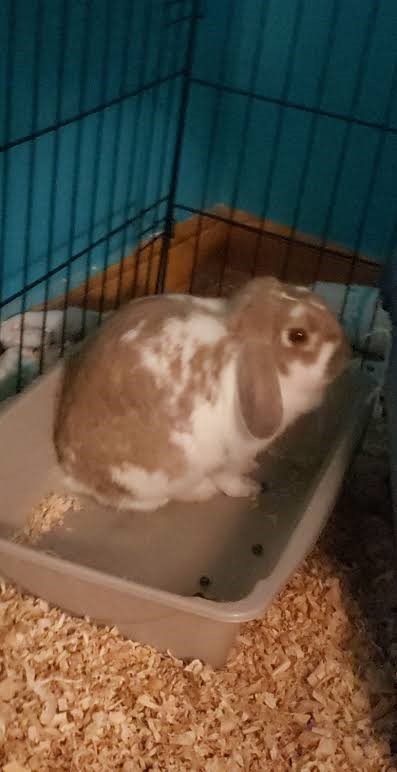
Like a lot of other breeds of rabbits, the Plush Lop can be housed both indoors and outdoors. An indoor housing or cage can be any standard cage that you can buy from a good pet store that specializes in selling rabbit-related products. The Plush Lop is not too picky when it comes to the type of cage you provide it. This rabbit also is not too shy and will not mind getting housed in a cage that allows it to get exposed out in the open. Also, since the Plush Lop is not the most active type of rabbit and is also a rather small and compact breed, you do not need to house it in a big cage.
Housing the Plush Lop outdoors also is a good idea as long as you live in a climate that is right for the rabbit. Providing it an enclosure that is made out of wood and wire is quite easy to do on your own. Just make sure that the wire fences are high enough so that your Plush Lop will not be tempted to escape by hopping over it. The good thing about an outdoor enclosure is that it is bigger, and it allows your rabbit to feel some sort of freedom.
However, it is recommended that an indoor enclosure should be the top pick for your Plush Lop. That is because this small rabbit is quite susceptible to different kinds of predators that can easily enter your yard. Snakes, reptiles, feral cats, and birds of prey will be able to prey on the small Plush Lop quite easily. Also, allowing it to spend time outdoors will make it more vulnerable to ticks, fleas, and other parasites. So, all that considered, house your Plush Lop indoors as much as possible. But if you insist on letting it live outdoors, make sure that you live in an area that is free from predators and that you try to keep an eye on any sort of parasite on your rabbit.
Availability – Where to Get one?
Plush Lops are some of the most common types of rabbits in America. Since the standard version is still under development, the more popular version is still the miniature variety. These rabbits can be found almost anywhere. A simple search on the internet will reveal several places where you can get your hands on a Plush Lop. Miniature Plush Lops can be purchased for a price that can be quite steep. Some breeders sell them for as much as almost $400, but you may be able to get cheaper ones from breeders that are not as reputable as the ones that sell expensive Plush Lops.
How to Care for a Plush Lop?
The good news when it comes to the Plush Lop is that it is a rabbit that is not too difficult to take care of. It generally has the same kind of demands as any other domesticated rabbit. This breed might be more affectionate and might need more of your attention, but it generally is just as easy to take care of like most other breeds of pet rabbits. In that case, it is not a pain in the neck to take care of.
Regardless of whether or not the Plush Lop is easy to take care of, it is very important to keep an eye on its overall health. Always make sure that you feed it the right kind of food and that it gets all of its nutritional needs from its daily diet. That means that you should provide it with grass-based food or rabbit pellets and the supplemental fibrous vegetables. Also, make sure that it is free from parasites such as fleas, ticks, and worms so that it will be able to live a healthy and fulfilling life that can potentially reach more than a decade.
Plush Lops should be housed indoors due to how they are prone to be targeted by predators, and because of how they will be more susceptible to parasites and illnesses outdoors. Nevertheless, so long as the conditions are right and safe for them, you can choose to house them outdoors. Still, it is recommended that you keep them safe in the comfort of your own home.
FAQs
Are Plush Lops ideal pets?
The Plush Lop is one of the best rabbits to have around as a pet due to its very affectionate and friendly demeanor. It hardly shows any signs of agitation and is perfect for any kind of household to have.
Where do Plush Lops originate from?
The miniature version of the Plush Lop was developed during the 1990s in America. Meanwhile, the standard Plush Lop is still under development but was started back in 2002 in Australia.
For what purpose was the Plush Lop bred for?
Unlike other domesticated rabbit breeds that were bred for their meat and their coat, the Plush Lop was specifically bred to be a pet for exhibition purposes.
What is the best way to interact with a Plush Lop?
When you want to interact with a Plush Lop, it is best to keep it around close with you and to try to cuddle with it. You can also have it rest and relax on your lap while you stroke its hair.
What are the two types of Plush Lops?
The Plush Lop comes in the miniature variety and the standard version. The miniature variety is impliedly smaller ,while the standard version is slightly larger.
What is the best kind of food to feed a Plush Lop?
Plush Lops thrive well on a diet that is mainly based on grass, hay, or rabbit pellets. You should supplement this diet with vegetables and leafy greens, as well.
What is the more popular variety of Plush Lop?
The miniature version of the Plush Lop that originated in America is known to be the older and more popular variety of this rabbit.
How big does a Plush Lop grow?
Depending on the variety, a Plush Lop can be somewhere between 2 to 5 pounds in terms of its overall body weight. However, these rabbits are generally regarded as compact and small compared to the other breeds of domesticated rabbits.
